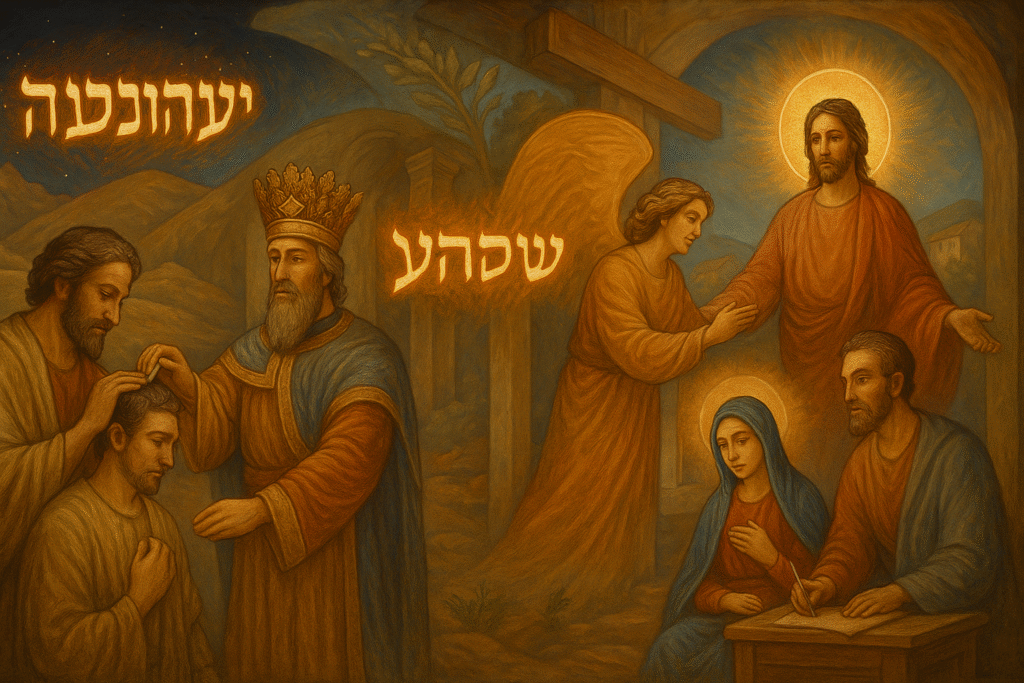Physical Address
304 North Cardinal St.
Dorchester Center, MA 02124
Physical Address
304 North Cardinal St.
Dorchester Center, MA 02124
With Michael Walker
With Michael Walker

A message to the New Creations….

The starting point is the Hebrew world of names. In the Scriptures, a name is not a disposable label; it is a revelation of identity and mission. When a name is spoken, its meaning is invoked, and when a person is given that name, the person becomes the living embodiment of that meaning. This is why the Old Testament repeatedly ties names to destinies: Abram becomes Abraham when his role expands, Jacob becomes Israel when his calling turns, Hoshea becomes Yehoshua when the mission shifts from human effort to Yahweh’s deliverance. If readers miss this Hebraic foundation, they will treat names as sounds and inevitably miss the theology.
Now place that foundation on a timeline. Think first in the era of Moses. Depending on which historical reconstruction you follow, Moses stands roughly in the 15th to the 13th century BCE. If you place the exodus in a 15th-century frame, the wilderness years fall in the 1400s BCE and the entry into the land under Joshua follows later in that century. If you place the exodus in the 13th-century frame, Moses is mid-1200s BCE and Joshua’s leadership follows before the turn of the 12th. Either way, this is the period when Numbers 13:16 reports that Moses changes Hoshea’s name to Yehoshua. Hoshea means salvation. Yehoshua means Yahweh saves. That single prophetic renaming moves salvation out of the realm of human strength and into the Name of God. This is the key type: Moses, representing Torah, can see the land but not bring the people into rest; Yehoshua, whose very name declares that Yahweh saves, leads them into inheritance. The name and the person fuse; the meaning and the mission become one.
Hold that type open and advance the clock to the late sixth and fifth centuries BCE, after the return from exile. Zechariah has night visions in the Persian period. In Zechariah 3 and 6 we meet Yehoshua the high priest, and Yahweh explicitly uses this historical Yehoshua as a sign of the coming Branch. He is crowned, he builds the temple, he unites priestly cleansing and royal authority in a prophetic picture. Once again the name Yehoshua is not an accident of family tradition; it is a vessel for a revelation, a forward-pointing arrow. The Tanakh still does not write, “the Son of God will be named Yehoshua,” but it keeps saying the same thing in the Hebrew way: it shows you the meaning Yahweh saves, it assigns that meaning to a person named Yehoshua, and it uses that person as a signpost to the One who is coming.
Now step forward into the Hellenistic world. Between roughly 250 and 150 BCE, Jewish scholars in Alexandria translate the Hebrew Scriptures into the common Greek of their day. This becomes the Septuagint. When those translators encounter the Hebrew name Yehoshua, they have to fit it into Greek phonetics. Greek lacks the “sh” sound, so shin is flattened. Greek does not carry a medial breathy “h” like Hebrew heh, so it drops. Greek masculine names typically end with an s to signal case endings. The result is Iesous. Crucially, this decision is not guessed in a vacuum; it is made two centuries before the angel ever speaks to Miriam. By the end of this translation project, every Greek-reading Jew has already learned that whenever the scroll says Joshua son of Nun, the Greek says Iesous. The dictionary link is established. Iesous equals Yehoshua. Yehoshua means Yahweh saves. The pipeline is in place.
Somewhere around the turn of the era, during the late reign of Herod and the early years under Roman administration, the messenger Gabriel appears to a young woman in Nazareth. Her world is Semitic; her prayers and Scripture are Hebrew; the street language of Galilee is Aramaic. It makes sense to assume Gabriel addresses her in her own tongue. The name he gives is Hebrew in substance: Yehoshua, the proclamation that Yahweh saves. When Matthew later writes the account in Greek, he records the name as Iesous and immediately supplies the explanatory key that the Greek ear already expects: you shall call his name Iesous, for he will save his people from their sins. That sentence is not a clever Greek play on words; it is the Greek writer preserving the Hebrew logic of the name. The meaning Yahweh saves has found its person; the person and the meaning collapse into the revealed Name.
From here the New Testament writings unfold across the first century CE. Luke composes his orderly account in Greek. Matthew writes with heavy gravity toward the Hebrew Scriptures yet records in Greek. Paul writes in Greek, the author of Hebrews writes in Greek. When they quote the Old Testament, they often quote the Septuagint wording because that is the Bible their mixed congregations can read in the synagogues of the diaspora. When Hebrews wants to recall the earlier Joshua as a figure of rest, it simply writes Iesous. The same spelling that names Joshua son of Nun in Greek now names the Messiah in Greek. No one imagines two different identities; they see the one line of meaning running beneath both.
It is important to pause and answer a question that often arises at this point. Why does the Old Testament never write a plain sentence that says the Son of God will be named Yehoshua? Because Hebrew prophecy almost never reveals destiny by pre-announcing syllables. It reveals destiny by embedding meaning, assigning that meaning to a person, letting that person’s life play the role, and then unveiling the fulfillment when the One arrives who is the sum of the meaning. Yahweh saves saturates the Psalms and prophets. Hoshea becomes Yehoshua so the mission is marked. Yehoshua the high priest is crowned as a sign of the Branch. Then, when the Son of God comes, the meaning and the person are married in the Name. That is how Hebrew revelation works.
At this point it is crucial to say what the Greek does and does not do. The Greek letters do not create a new brand. They serve as a vessel. Iesous is the known Greek echo of Yehoshua; it carries the meaning across a language boundary for readers who cannot sound out Hebrew. The substance of the Name lives upstream in the Tanakh and in the Hebrew speech of the angelic announcement. The Septuagint simply pre-teaches the Greek-speaking world which sound goes with which Hebrew reality, two centuries before the birth. When the Gospel writers reach for Iesous, they are not improvising; they are walking a well-worn bridge their audience already trusts.
There is also a practical pastoral point that helps beginners. Some will ask about the shorter post-exilic form Yeshua that appears for several men in later books. In Jewish life of the Second Temple period, both the longer Yehoshua and the contracted Yeshua circulated. Both point to the same root yasha, to save, and both are rendered as Iesous in Greek. The theological heartbeat we are tracing is not about preference for one spelling as a cultural marker; it is about seeing that the Name the angel gives is not a novelty but the fulfillment of the meaning Yahweh saves which the Scriptures have been singing for centuries. If a reader understands that, then the surface forms will never again distract from the substance.
Now gather the whole arc in time. In the wilderness under Moses, more than a millennium before Miriam, the prophetic renaming from Hoshea to Yehoshua sets the type and declares the message that salvation belongs to Yahweh. In the post-exilic visions of Zechariah, roughly five hundred years before Miriam, the high priest named Yehoshua is ordained as a sign of the coming Branch who will wear the crown and build the true temple. In the Greek translation work of the third to second centuries before Miriam, the community standardizes the way Yehoshua is heard in Greek as Iesous, establishing the sound-bridge well in advance. In the years just before the common era breaks into the first, the angel speaks in a Semitic tongue to a Semitic woman and gives the Name whose meaning was already revealed. In the decades that follow, the eyewitnesses and their companions preserve the story in Greek and use the same Greek name their Scriptures had been using for Joshua for generations. At no point is a new identity invented; every point is another mile-marker on the same road.
If you explain it this way to a newcomer, the pieces fall into place at an elementary level. The Old Testament never prints the sentence that the Son of God will be named Yehoshua; instead it saturates the narrative with the meaning Yahweh saves, then assigns that meaning to a person named Yehoshua at two decisive moments, conquest and cleansing, and teaches the Greek world to hear that name as Iesous. When the Son arrives, the angel speaks the Name that matches the mission, and the authors record it with the Greek form their readers already know. Meaning plus person equals Name. Name equals mission revealed in a person. The Greek spelling is the symbol; the Hebrew Name is the substance; the substance is fulfilled in the Son.
The conclusion, then, is simple and weighty enough to teach a child and sturdy enough to satisfy a scholar. The Name was not made up on the spot in Greek. It was forged in the desert when Hoshea became Yehoshua and the people learned that Yahweh alone saves. It was carried through the centuries in the high priest whom Zechariah crowned as a sign of the Branch. It was codified for the Greek ear two hundred years before Miriam ever heard an angel’s voice. It was spoken over the child as the only Name that could tell the truth about his mission. And it was written down in Greek letters that did not erase the Hebrew, but faithfully pointed back to it. If you remember that Hebrew names are revelations, you will never again be confused by the surface. Iesous is the echo. Yehoshua is the Name. Yahweh saves is the meaning. The Son is the living fulfillment.